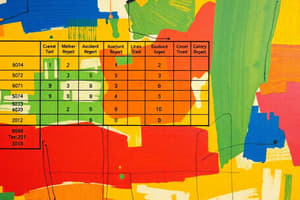Podcast
Questions and Answers
What is another term for norm-referenced cut score?
What is another term for norm-referenced cut score?
Norm-referenced cut score is also referred to as a relative cut score.
Which method for setting fixed cut scores involves judgments from an expert panel?
Which method for setting fixed cut scores involves judgments from an expert panel?
- IRT-Based Methods
- Angoff Method (correct)
- Bookmark method
- Known Groups Method
Low inter-rater reliability is a weakness of the Angoff Method.
Low inter-rater reliability is a weakness of the Angoff Method.
True (A)
In the IRT framework, each item is associated with a particular level of ________.
In the IRT framework, each item is associated with a particular level of ________.
Match the expert method of setting cut scores with its description:
Match the expert method of setting cut scores with its description:
Define utility in the context of testing and assessment.
Define utility in the context of testing and assessment.
What factors affect a test's utility?
What factors affect a test's utility?
What is a utility analysis?
What is a utility analysis?
The ________ formula provides an estimate of the benefit of using a particular test or selection method.
The ________ formula provides an estimate of the benefit of using a particular test or selection method.
Complex jobs may require different utility analysis methods based on their complexity.
Complex jobs may require different utility analysis methods based on their complexity.
Flashcards are hidden until you start studying
Study Notes
Module Overview: Utility in Psychological Assessment
- The module discusses the properties of good test utility, including different methods of utility estimation in test development.
Learning Objectives
- Explore different methods of setting cutoff scores
- Determine the importance of utility analysis in test standardization
- Compare and contrast different methods of setting cutoff scores
- Value the characteristics of a good test
What is Utility?
- Utility in the context of testing and assessment refers to the usefulness or practical value of testing to improve efficiency.
- It refers to the practical value of using a test to aid in decision-making.
Factors Affecting a Test's Utility
- Psychometric soundness: a test is said to be psychometrically sound if reliability and validity coefficients are acceptably high.
- Costs: economic, financial, or budget-related factors that must be taken into account in utility analysis.
- Benefits: profits, gains, or advantages of using a test, including economic and non-economic benefits.
Utility Analysis
- A utility analysis is a family of techniques that entail a cost-benefit analysis to yield information relevant to a decision about the usefulness and practical value of a tool of assessment.
- It involves evaluating whether the benefits of using a test outweigh the costs.
Conducting a Utility Analysis
- Expectancy data: an expectancy table provides an indication of the likelihood that a test-taker will score within a certain interval of scores on a criterion measure.
- The Brogden-Cronbach-Gleser formula: a formula used to estimate the dollar amount of a utility gain resulting from the use of a particular selection instrument under specified conditions.
Methods for Setting Cut Scores
- The Angoff Method: a method for setting fixed cut scores that involves expert judgments about how a person with a particular trait or ability would respond to test items.
- The Known Groups Method: a method that involves collecting data on the predictor of interest from groups known to possess and not to possess a trait, attribute, or ability.
- IRT-Based Methods: methods that use item response theory to set cut scores, including the item-mapping method and the bookmark method.
- Other Methods: the method of predictive yield, regression, and discriminant analysis are also used to set cut scores.
Studying That Suits You
Use AI to generate personalized quizzes and flashcards to suit your learning preferences.




